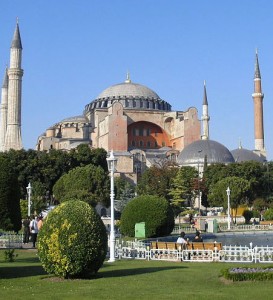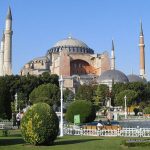ISTANBUL (Morning Star News) – While protests in Turkey against the destruction of Istanbul’s Taksim Gezi Park have grabbed international headlines, the conflict is only a small part of a wider government campaign to transform public areas and non-Muslim holy sites into Islamic spaces – including what was once the world’s largest church building.
This spring the Turkish Parliament’s Petition Commission began considering an application to turn Istanbul’s iconic Hagia Sophia – a six-century basilica that for centuries was the symbol of Eastern Christianity – into a mosque. A museum since 1935, the Hagia Sophia previously was converted into a mosque after the 1453 conquest of Constantinople by the Ottoman Turks, forerunners of the Turkish Republic.
Three citizens from northwestern Turkey wrote the application to transform the Hagia Sophia from museum to mosque, and they included a survey of 401 people, of which 97 percent requested it be turned into a functioning place of Islamic worship, according to the Hurriyet Daily News.
Some analysts believe that the attempt points to a larger project of the ruling Justice and Development Party (AKP) to turn more of the nation’s buildings and public spaces into Islamic places of worship.
“The AKP sometimes operates openly, and sometimes it operates behind-the-scenes,” Michael Rubin, Middle East specialist at the American Enterprise Institute (AEI), told Morning Star News. “The perception – both inside and outside Turkey – is that this initiative is proceeding with the AKP’s blessing.”
Such an undertaking faces considerable difficulties, and at the moment the plan is only at the committee level in parliament. No actions or comments by Prime Minister Recep Tayyip Erdoğan have suggested that definite plans are underway. The initiative may be a trial balloon, however, to see how much power the party has; the AKP wields significant force but still faces resistance from a vastly diminished military and a civil society that has offered up robust demonstrations against Erdoğan this month.
“The AKP will find itself between electoral support that wishes to see mosques returned to museums and an army establishment that is dead-set against the idea,” said Kevin Newton, an analyst on Middle East social and political issues for Habbibi Consulting. “It is quite possible that the AKP is using this opportunity as a barometer to see just how far it can push its luck against the army.”
Foundations Directorate Head Adnan Ertem has openly advocated for Istanbul’s Hagia Sophia to be turned into a mosque.
“The Hagia Sophia Mosque in Istanbul is a mosque, and will remain one forever,” Ertem said, according to the Hurriyet Daily News. “However, we are not the authority [to open the mosque to prayers]. We can only voice the state of it, and the fact that it is accepted as a mosque by everyone, but we cannot decide on it.”
Istanbul has turned into a giant construction zone since the AKP began its rule 10 years ago, and since coming to power Erdoğan has managed to put an Islamic spin on many projects. High-rise construction projects dot the skyline. Hundreds of miles of bridges, highways, metro lines, and tramways have been added. This year the government will open its highly vaunted Marmaray project, a metro line that will travel underneath the Bosphorus Strait and connect the European and Asian parts of the city.
Other grandiose projects include digging a 50-kilometer (31-mile) canal east of Istanbul to ease the heavy ship traffic that moves through the Bosphorus. The Panama Canal-style dredging would turn the European side of Istanbul into an enormous, Manhattan-like island.
Erdoğan often announces such projects in ceremonies on May 29, the anniversary of 1453 Islamic conquest of Constantinople. This year on May 29, he announced that a new Bosphorus bridge would be named Yavuz Selim Sultan, after the 16th-century sultan who conquered the Middle East and the Islamic holy cities of Mecca and Medina. Sultan also slaughtered thousands of Alevis, a beleaguered Muslim minority group that numbers in the millions in Turkey, earning him the nickname “The Grim.”
Erdoğan announced on the same day in 2012 that a mega-mosque would be built that will fit 30,000 worshippers and dominate the city skyline. It will cover 15,000 square meters, along with another 250,000 square meters that will house a complex containing restaurants. Erdoğan claimed that the mosque would be ‘‘visible from anywhere in the city’’ with ‘‘the highest minarets in the world.”
It will also have six minarets – a bold statement considering that the only mosque in Turkey that has that many is the Sultanahmet mosque, the 17th-century masterpiece that was intentionally built across from the Hagia Sophia in order to challenge its impressive architecture.
Kemal Kilicdaroglu, leader of the opposition People’s Republic Party (CHP), said that such plans were an act of “genocide” against the city’s skyline
The issue of the mega-mosque, still unnamed, is a controversial one in Turkey; secularists see it as religious overreach by the government to put an Islamic imprint on public life. But the country’s small Christian community does not see it as a pressing issue, other than the troubles it might cause in opening up churches.
“In my opinion this is not an issue that concerns us Christians,” Carlos Madrigal, leader of the Istanbul Protestant Church Foundation, said of the prospective mega-mosque. He said it was a municipal issue of determining if such a large structure was necessary for the neighborhood’s Muslim population.
Madrigal, one of the most prominent members of Turkey’s Protestant community, told Morning Star News that such building projects will affect the city’s famous skyline more than the country’s Christians. Trained as an architect before becoming a pastor, Madrigal is sensitive to aesthetics and designed a Protestant church in Izmit, 62 miles (100 kilometers) east of Istanbul.
He is more concerned with government policies that make registering a new Christian church very difficult. Government permission is required for a meeting place larger than 2,000 square meters or for changing a construction plan. Obtaining permission can take years.
Madrigal leaves the issue of the utility of such a large mosque to Istanbul’s Muslim population.
“Is a mosque being built there in order to meet worship needs or to put on appearances?” he said. “I think this is the real question for those who are making the mosque.”
Erdoğan’s plan to build a large mosque that will alter the face of the city hearkens back to a tradition among the Ottoman sultans. Sultan Suleyman, the 16th century ruler who was the most powerful in the empire’s history, commissioned numerous mosques in the city’s historic district that still mark the skyline.
The eponymous Suleymaniye mosque is one of the best-known landmarks in the city. It was designed as a way for Suleyman to represent himself as the “second Solomon” and to supplant the grandeur of the older Byzantine churches in the city.
Gezi Park
The AKP’s plans also include changing the face of Taksim Square, the central thoroughfare of the city. The recent Taksim Gezi Park protests were a reaction against tearing down the park and replacing it with a replica of Ottoman-era Topcu Barracks that would house a museum and a shopping mall.
The barracks represent what some see as a rebuke to Turkey’s secular past. They originally housed soldiers who resisted the 1909 Young Turk revolution, a secularist overthrow of the government that deposed the Islamist sultan Abdulhamid II.
Prime Minister Ismet Inonu tore it down in 1938. Prime Minister Necmettin Erbakan, however, wanted to restore it as a symbolic move and came to power in 1996 promising also to put a mosque in the square. His party, of which Erdoğan was a member, was disbanded by the military in 1997 for suspected Islamic activity.
Erdoğan’s desire to restore the barracks and build a large mosque that would sit across from an old Greek Orthodox church as a means to commemorate the Ottoman Empire’s multi-religious heritage is a continuation of this dream. It is a way to complete Erbakan’s desire to re-Islamify the square.
“Powerful leaders in Turkey, [President Mustafa Kemal] Atatürk and [Prime Minister] Turgut Özal, for example, both sought to put their marks on society with building projects,” Rubin of the AEI said. “Erdoğan is no different, but by emphasizing mosques, he is symbolically reversing decades of Kemalism and reorienting Turkey to a religious rather than nationalistic heritage.”
Many other parts of the country have already undergone this transformation. Approximately 17,000 mosques have opened in the last decade, increasing the country’s total from 76,000 to 93,000. The government has declared the area around them as de facto sacred spaces, as alcohol is not allowed to be sold within 100 meters of them.
Another church called Hagia Sophia is being turned into a mosque. The 13th-century church in the Black Sea city of Trabzon will be turned into an Islamic house of worship following a legal battle that ended when Turkey’s Ministry of Culture and Tourism declared that allowing the church-turned-mosque to remain as a museum was an “illegal occupation.” This has set a precedent for other structures to be turned into mosques.
Turkey’s population of 73.2 million is 96.6 percent Muslim, according to Operation World. Only 7,267 of its residents are evangelical Protestants, and another 7,233 are Charismatics/Pentecostals, followed by 33,000 ethnic Armenian Orthodox faithful and 18,563 Roman Catholics, according to Operation World. In all, Christians make up only 0.21 percent of the Turkish population.
Ambitions Abroad
Turkey’s ambitious mosque program is not restricted to its borders. Its Directorate of Religious Affairs has funded and overseen the construction of hundreds of mosques in Germany, where millions of Turkish immigrants live. In Cologne, a mosque is under construction that will hold 1,200 and cost $40 million. It will include 100-foot high minarets that will preside over the local landscape, according to the European Freedom Initiative.
In the United States, a 15-acre, $100-million mosque will open in Lanham, Md., in 2014. Erdoğan visited the site on May 15 at a ground-breaking ceremony, where he laid the site’s cornerstone.
It will be dubbed the Turkish American Culture and Civilization Center , and its goal is to “serve as a social, cultural, and religious center for all visitors, including activities for the promotion and introduction of the values of the Turkish civilization” according to an information packet distributed at the ceremony.
Erdoğan promised that he would be at the site in 2014 for the official opening of the center, but “only if I am still around,” he said.
###
© 2013 Morning Star News. Articles may be reprinted with credit to Morning Star News.
Morning Star News is a 501(c)(3) non-profit corporation whose mission is to inform those in the free world and in countries violating religious freedom about Christians worldwide who are persecuted for their faith. For free subscription or to make tax-deductible donations, contact [email protected], or send check to Morning Star News, 24310 Moulton Parkway, Suite O # 157, Laguna Hills, CA 92637, USA.
- Hagia Sophia, whose name is Greek for “Holy Wisdom.”



Speak Your Mind